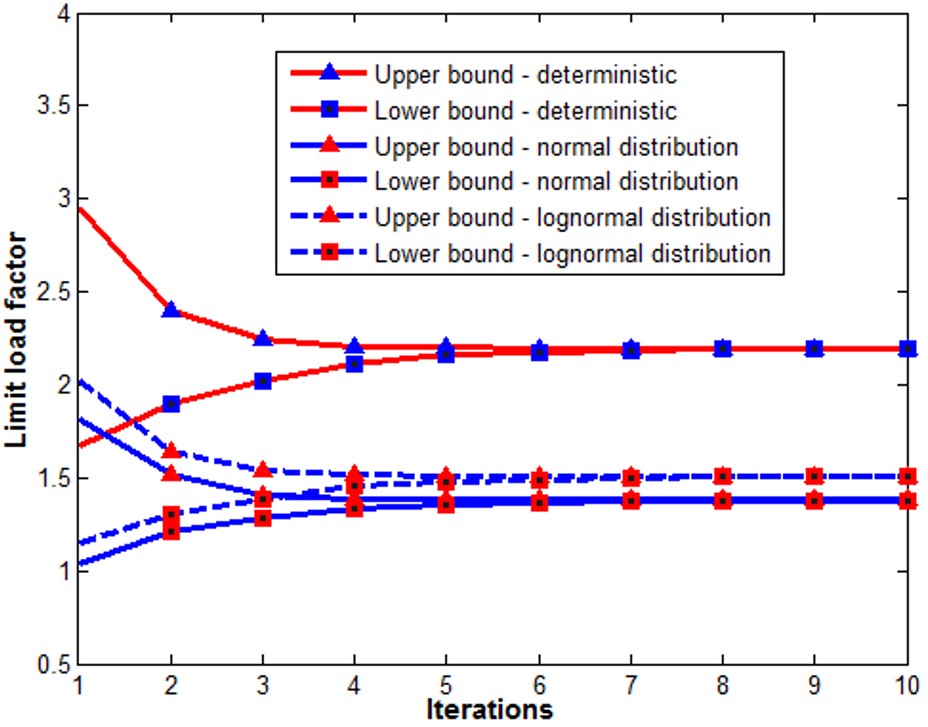FEM shakedown analysis of structures under random strength with chance constrained programming
Author affiliations
DOI:
https://doi.org/10.15625/0866-7136/17943Keywords:
limit analysis, shakedown analysis, chance constrained programming, stochastic programming, reliability of structuresAbstract
Direct methods, comprising limit and shakedown analysis, are a branch of computational mechanics. They play a significant role in mechanical and civil engineering design. The concept of direct methods aims to determine the ultimate load carrying capacity of structures beyond the elastic range. In practical problems, the direct methods lead to nonlinear convex optimization problems with a large number of variables and constraints. If strength and loading are random quantities, the shakedown analysis can be formulated as stochastic programming problem. In this paper, a method called chance constrained programming is presented, which is an effective method of stochastic programming to solve shakedown analysis problems under random conditions of strength. In this study, the loading is deterministic, and the strength is a normally or lognormally distributed variable.
Downloads
References
J.-W. Simon and D. Weichert. Shakedown analysis of engineering structures with limited kinematical hardening. International Journal of Solids and Structures, 49, (2012), pp. 2177–2186.
M. Staat. Limit and shakedown analysis under uncertainty. International Journal of Computational Methods, 11, (2014).
M. Staat and M. Heitzer. Probabilistic limit and shakedown problems. In Numerical Methods for Limit and Shakedown Analysis. Deterministic and Probabilistic Approach. Part VII. NIC Series, Vol. 15. John von Neumann Institute for Computing, Jülich, (2003), pp. 217–268.
M. Staat and M. Heitzer.Numerical methods for limit and shakedown analysis. In Deterministic and Probabilistic Approach. NIC Series, Vol. 15. John von Neumann Institute for Computing, Jülich, (2003).
T. N. Tran, G. R. Liu, H. Nguyen-Xuan, and T. Nguyen-Thoi. An edge-based smoothed finite element method for primal-dual shakedown analysis of structures. International Journal for Numerical Methods in Engineering, 82, (2009), pp. 917–938.
F. Tin-Loi and Z. Wei. Elastoplastic analysis of structures under uncertainty: model and solution methods. Numerical Functional Analysis and Optimization, 20, (1999), pp. 353–365.
N. T. Trần. Limit and shakedown analysis of structures under stochastic conditions. PhD thesis, Technische Universität Carolo-Wilhelmina zu Braunschweig, Braunschweig, Germany, (2018).
D. K. Vu. Dual limit and shakedown analysis of structures. PhD thesis, Université de Liège, Belgique, (2002).
S. Kataoka. A stochastic programming model. Econometrica, 31, (1963), pp. 181–196.
A. Charnes and W. W. Cooper. Chance constraints and normal deviates. Journal of the American Statistical Association, 57, (1962), pp. 134–148.
N. T. Trần and M. Staat. Direct plastic structural design under lognormally distributed strength by chance constrained programming. Optimization and Engineering, 21, (2019), pp. 131–157.
K. A. Sikorski and A. Borkowski. Ultimate load analysis by stochastic programming. In Mathematical Programming Methods in Structural Plasticity. Springer Vienna, (1990), pp. 403–424.
N. T. Tran, T. N. Tran, H. G. Matthies, G. E. Stavroulakis, and M. Staat. Shakedown analysis under stochastic uncertainty by chance constrained programming. In Advances in Direct Methods for Materials and Structures. Springer International Publishing, (2017), pp. 85–103.
T. Belytschko. Plane stress shakedown analysis by finite elements. International Journal of Mechanical Sciences, 14, (1972), pp. 619–625.
F. Genna. A nonlinear inequality, finite element approach to the direct computation of shakedown load safety factors. International Journal of Mechanical Sciences, 30, (10), (1988), pp. 769–789.
G. Garcea, G. Armentano, S. Petrolo, and R. Casciaro. Finite element shakedown analysis of two-dimensional structures. International Journal for Numerical Methods in Engineering, 63, (8), (2005), pp. 1174–1202.
T. N. Tr`ân and M. Staat. An edge-based smoothed finite element method for primal-dual shakedown analysis of structures under uncertainties. In Limit State of Materials and Structures. SpringerNetherlands, (2013), pp. 89–102.
F. A. Gaydon and A. W. McCrum. A theoretical investigation of the yield point loading of a square plate with a central circular hole. Journal of the Mechanics and Physics of Solids, 2, (1954), pp. 156–169.
M. Staat, M. Heitzer, H. Lang, and K.Wirtz. Direct finite element route for design-by-analysis of pressure components. International Journal of Pressure Vessels and Piping, 82, (2005), pp. 61–67.

Downloads
Published
How to Cite
License

This work is licensed under a Creative Commons Attribution-ShareAlike 4.0 International License.









